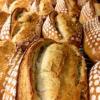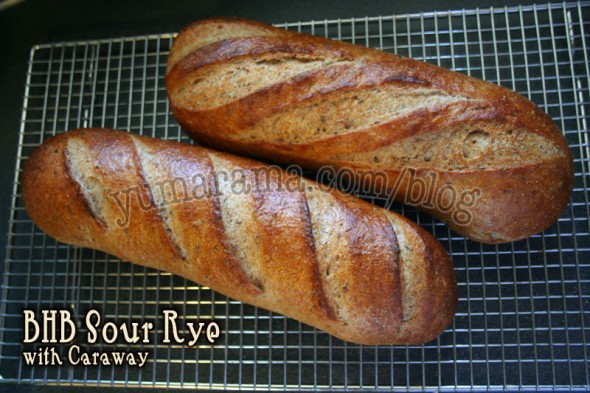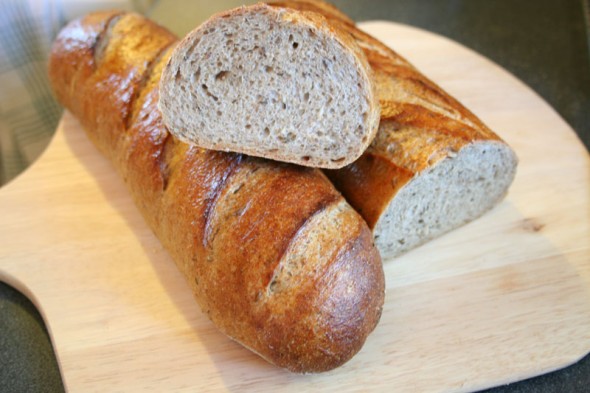
Sour Rye from Back Home Bakery recipe
I recently made some sour rye bread using Mark's recipe from The Back Home Bakery. I posted the complete photo step-by-step on my blog here if you want all the dirty details, but here's the final product;


I'm not totally sure the crumb is as open as it should be, although it's about 36% rye to 64% AP and is a 63% hydration dough. It seems just a wee bit too tight, but maybe that's just me. I'm thoroughly happy with the taste (and pretty dang proud of finally getting good slashes!) so if this is indeed "pretty much spot on" then I've got no complaints.
Can anyone suggest what one might do if that isn't what the crumb texture is supposed to be?
Hopefully even a word from Mark would be great but I assume he's got a day job that keeps him busy. And "day" is pretty subjective here, from what I've been seeing lately ;)
Normally, I'd include the recipe but since Mark has taken them off his site after going into business full swing, I don't want to be giving away the shop secrets.
Thanks in advance for any tips.


Why would you wonder if the crumb is as open as it should be. I think there is a misconception about "open" crumb. I would think a rye loaf would want a crumb similar to yours.....for sandwiches????? I think open crumb is for artisanal breads with higher percentages of hydration. If all breads were open crumb, what would we make sandwiches with. The mustard, mayonnaise, dressing, olive oil, butter, jelly all goes through the open crumb and lands on your trousers. Nope! For me, I want a crumb similar to yours for my sandwiches. Open crumbs are for dipping in olive oil and sauces as dinner accompaniaments.
I take that back....if the chiabatta, baguette, or foccacia is sliced between the crusts, then they are good for sandwiches...but some breads are meant to have less open crumb for me....especially a rye bread such as yours which is begging for sandwich fillings.
Looks good to me rainbowz. I especially like the color and slashing pattern. Great job!
Eric
Yumm, Rye with Caraway! Lovely looking loaves!
Sylvia
Hi, rainbowz.
Very fine-looking rye breads. The crumb is quite typical of a 40-ish percent rye bread. You hit the bulls eye.
David
rainbowz,
That looks very much like the ryes we were pulling out of the oven at The Back Home Bakery. The only significant difference in appearance is that Mark brushes on an egg wash and sprinkles on a copious amount of poppyseeds before slashing, then lets them bake to a very deep shade of brown. The crumb looks very much like what you have pictured. Good work!
Paul
Great looking bread.
Hey thanks for giving credit to me for the Rye recipe, but truth be told, the guy who posted the recipe originally is about 4 posts above here. I adapted the recipe from Eric's (ehanner).
-Mark
OK Eric, whats the recipe?
Thanks.
Your bread looks wonderful and I can only hope to create a rye loaf that looks half as good!
And thanks for all the step by step photos in you blog!
Hamelman's BREAD, page 194-195:
40% Rye by Hamelman
Looks like the quantities are a bit different in Eric's from Hamelmans, which in turn are different from Mark's amounts.
Which are different from the ones I used. But as long as everyone's ratios remain the same... same recipe all around!
I did use a cornstarch glaze where Mark calls for egg wash and poppy seed. Eric went naked. Ditto Hamelman.
your bread looks great, and I agree with the posters above who say that the crumb is perfect. No need for improvements.
-Mark
This was one of those times when I worked very hard to make this bread all I could make it be. I must of tried a dozen different combination's. I looked at secrets of a Jewish Baker and a couple from the Internet at first. I hadn't bought Hamelmans Bread yet so it didn't come from there.
In the end, I found that I had rediscovered the old world and chased my tail back to Hamelmans formula. As they say, all's well that ends well.
I also do a version using re-hydrated onions and water from that process to flavor the bread. This is a trick I learned from Norm Berg, (NBI Computers). If you haven't tried this yet, I recommend you stop what ever you are doing and get yourself some dry onions and try this bread. As someone said, it smells like Heaven or a Jewish Bakery (probably the same place). After the wash a liberal cover of my "everything seeds" plus garlic chips and salt, and you have a very flavorful rye. It's a long way from "Deli Rye" but delicious.
So, I laugh every time I see Mark give me credit for this rye. His improvements have made it the great loaf it is now. Hope this clears up the confusion.
Eric
Thanks for the extra info, Eric. Would you two be OK with me including the recipe on the blog? Or more specifically, adding the specific ingredients/quantities list? I've already had a few people ask for it...
Also, how come the choice of All Purpose flour and not Bread or, as in Hamelman's version, high-gluten? Would the extra gluten not help the low-gluten rye along?
that you were crediting me for the recipe when your loaves had a cornstarch finish like Eric does on his (as opposed to the poppyseed thing).
I'd prefer if you wouldn't post my adaptations to his recipe since I'm deliberately not publishing them myself. Eric can of course make the call on the use of his recipe.
I tend to use whichever quality local all-purpose flour I can find at a reasonable cost. In Vermont I used KA all-purpose, in Hawaii I used the Costco Con-Agra stuff, here I use Wheat Montana - its protein content is 'off the charts' at the bagel level (16%), so although it's called an all-purpose flour, they also call it a bread flour since they only make one unbleached white.
Hope that answers your questions.
-Mark
So I'll retain the "It's Mark's Secret!" aspect (it adds a little mystique too!) and I guess the easiest alternative will be to point to Eric's post over here since it really is somewhat similar and, clearly, already "out there".
Thanks for everyone's input so far, I'll update the post to reflect some of your additional info.
to a German's eyes. Coming from the land of sourdough, our bread never had huge holes in it. Where would all that sweet melting butter go ???? grin grin